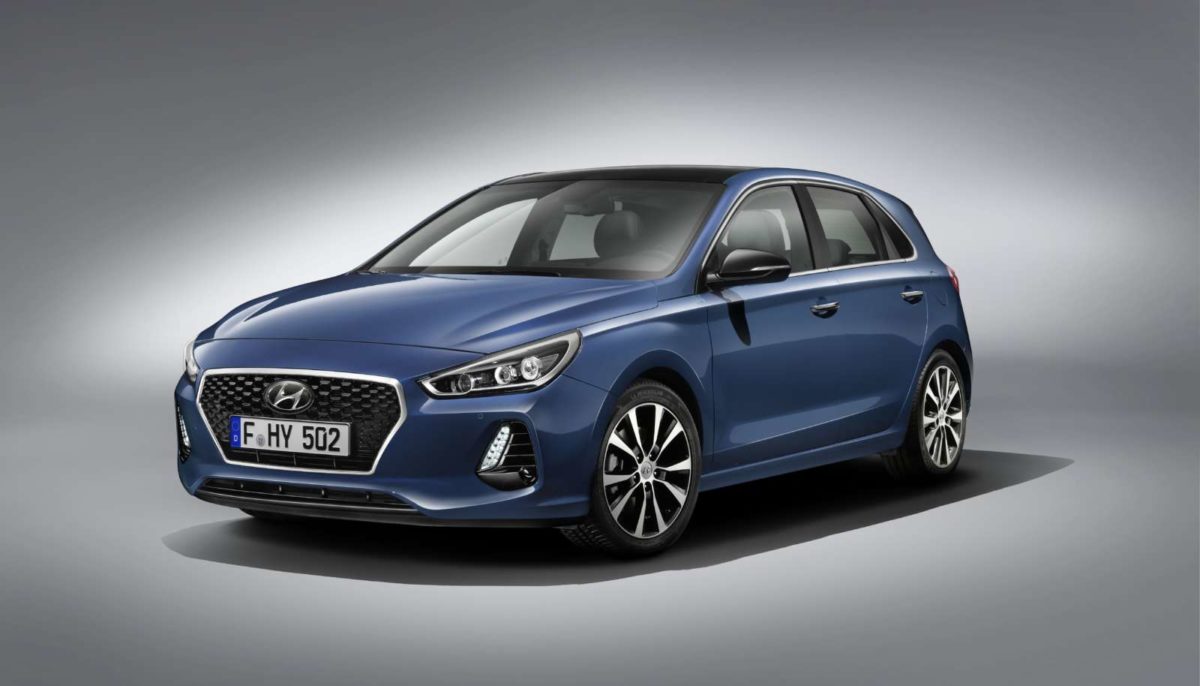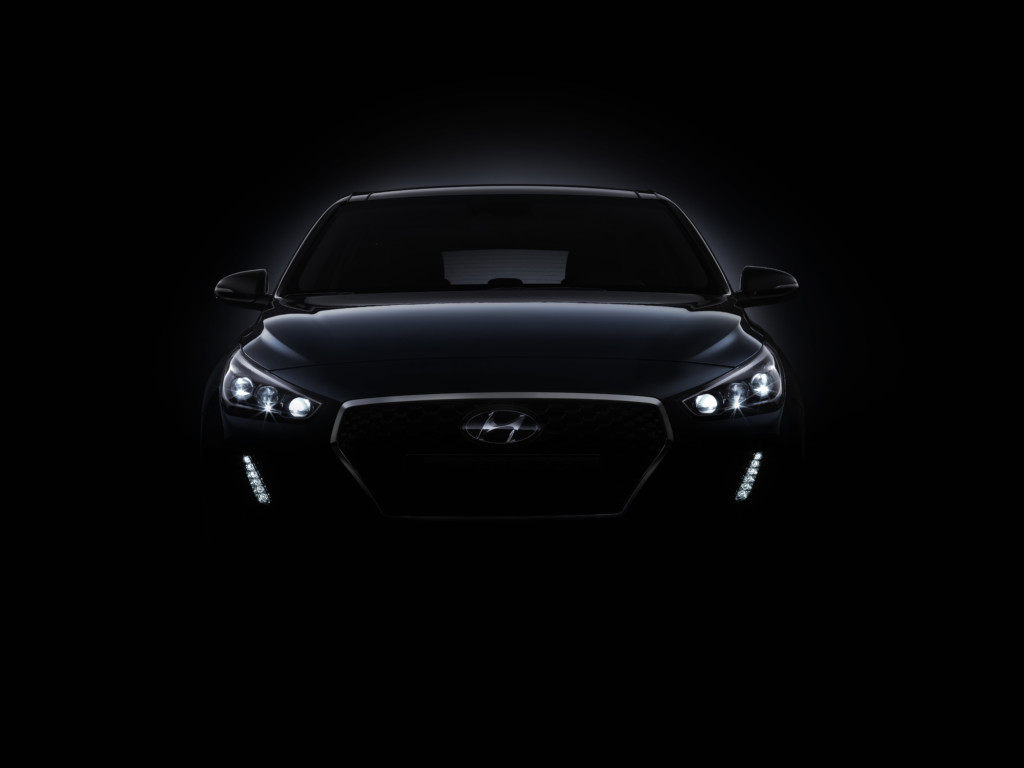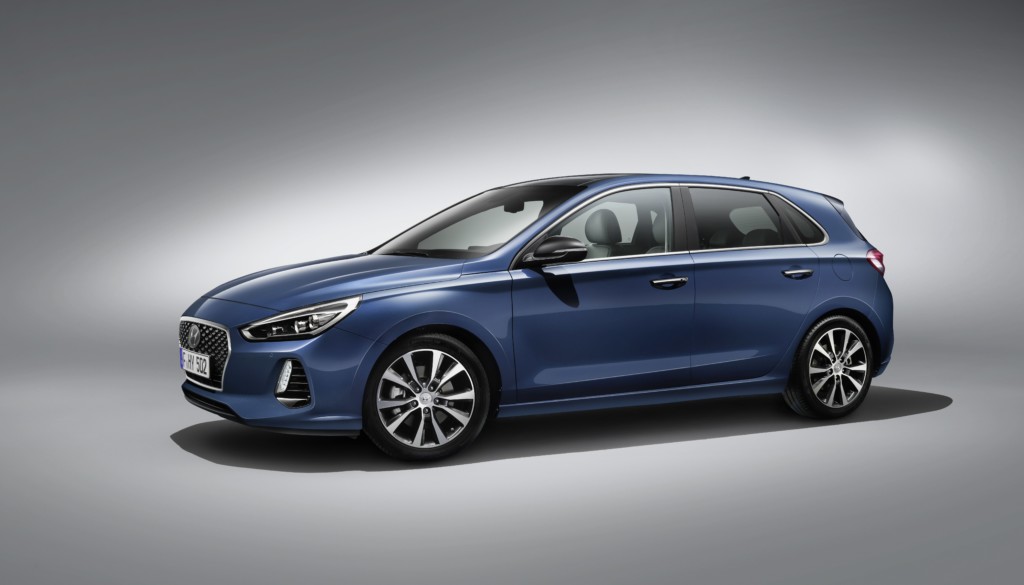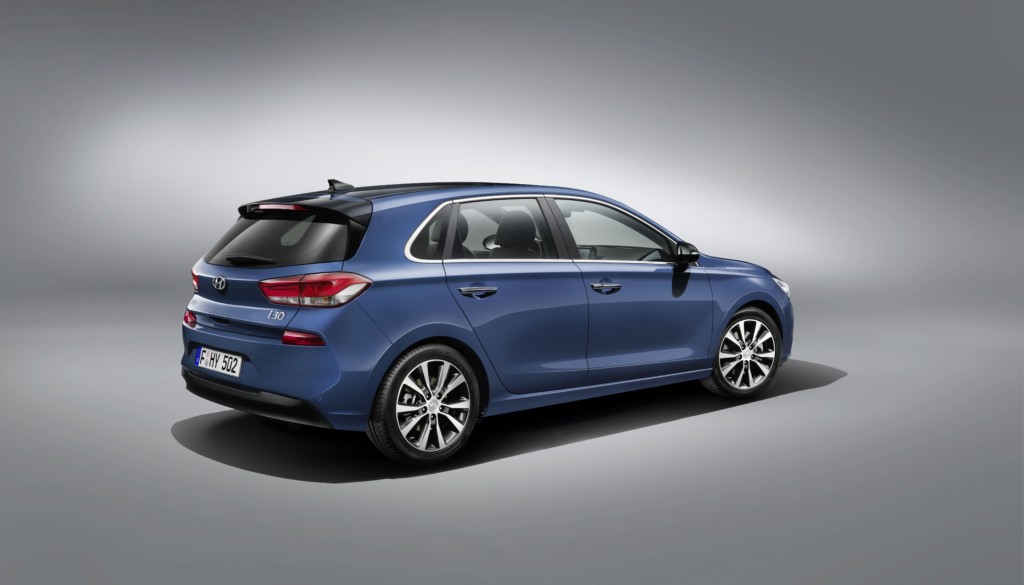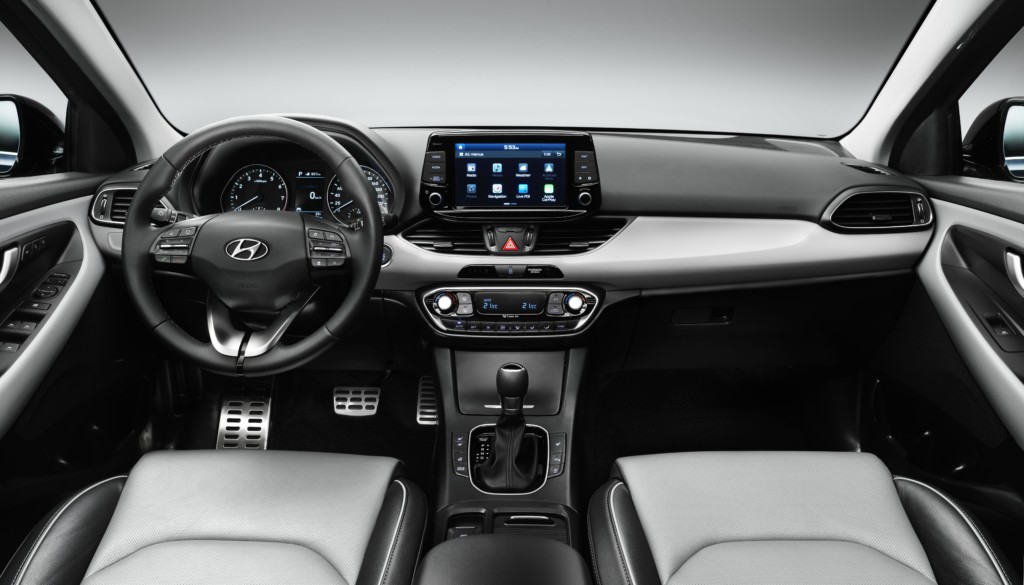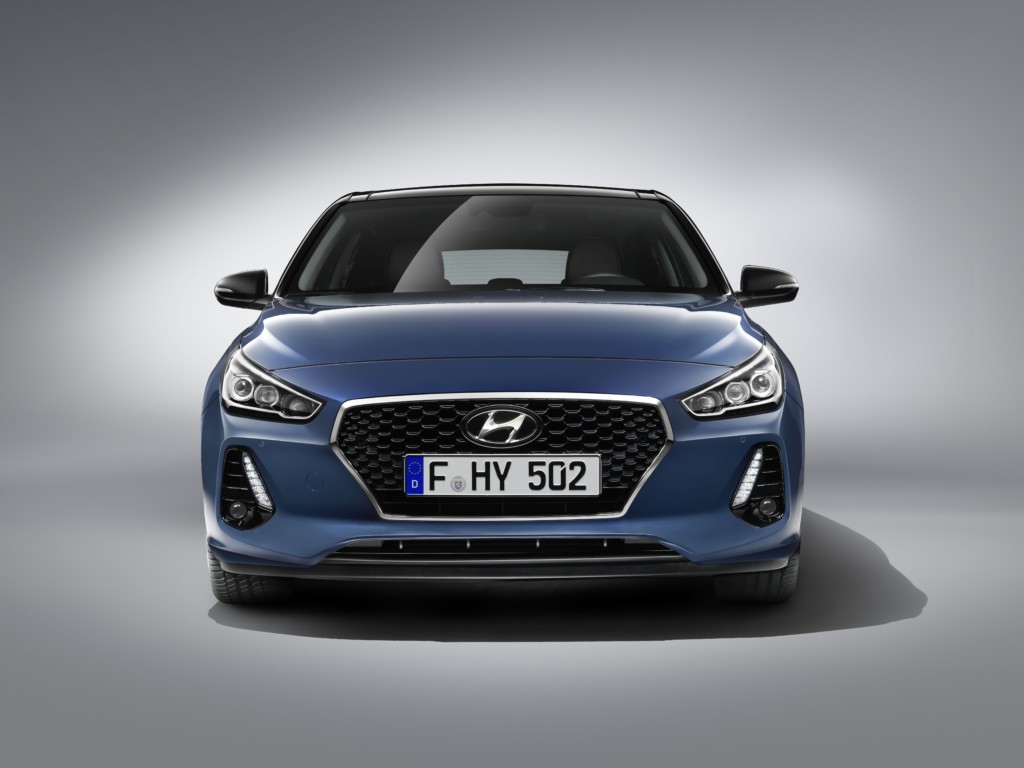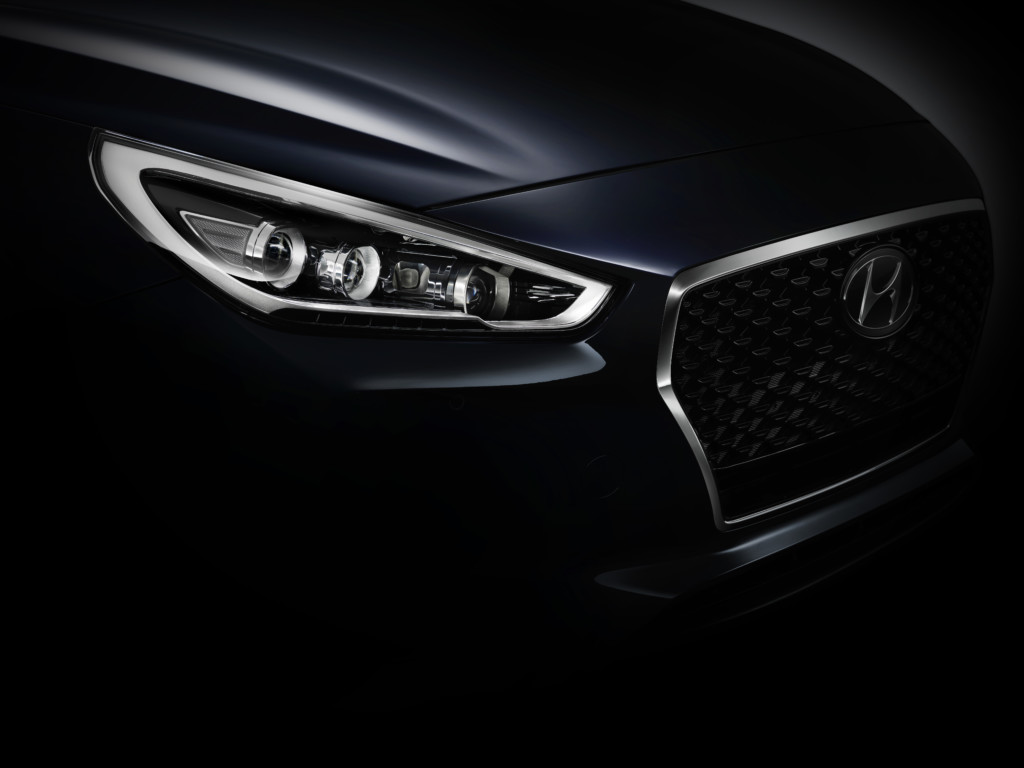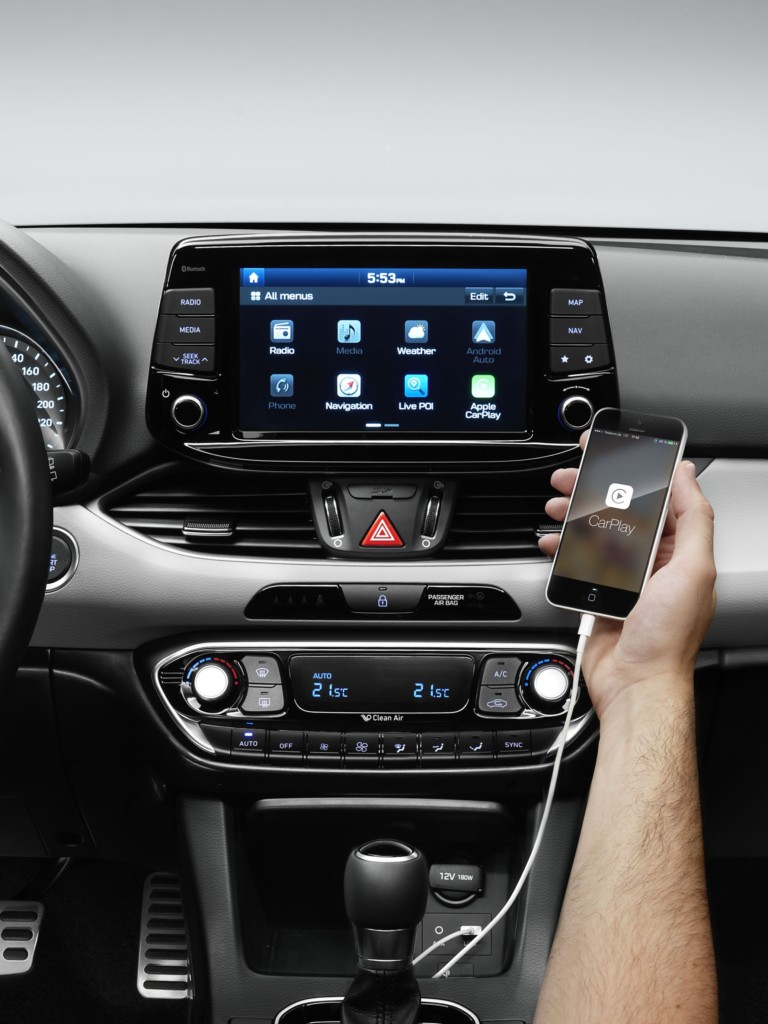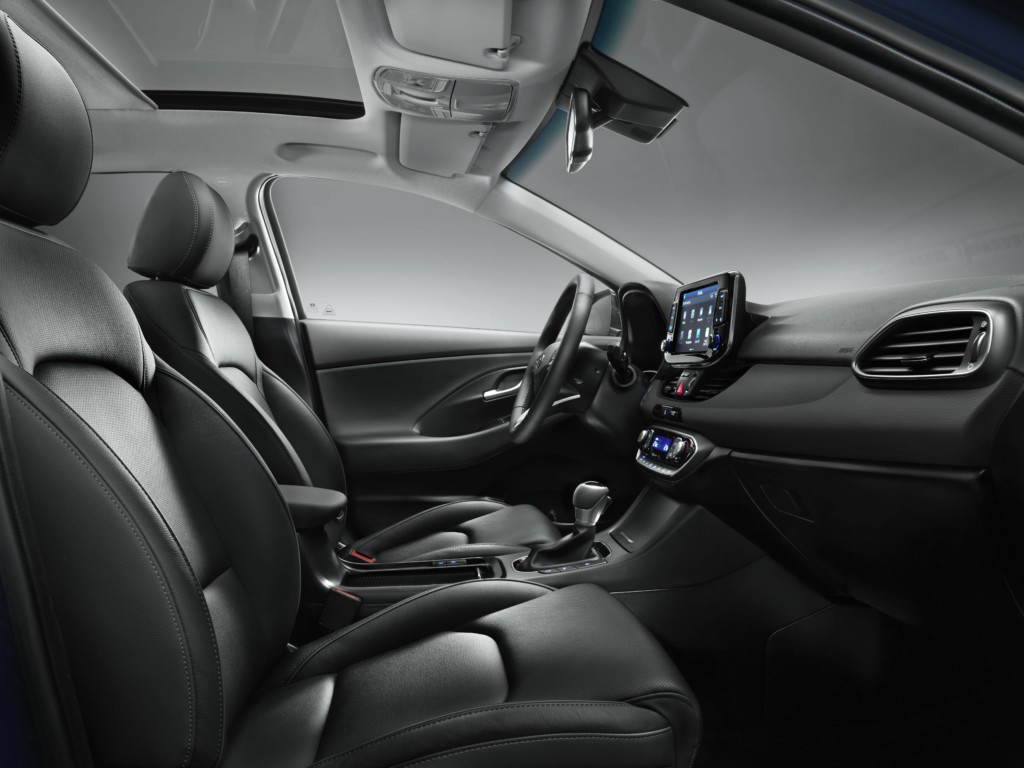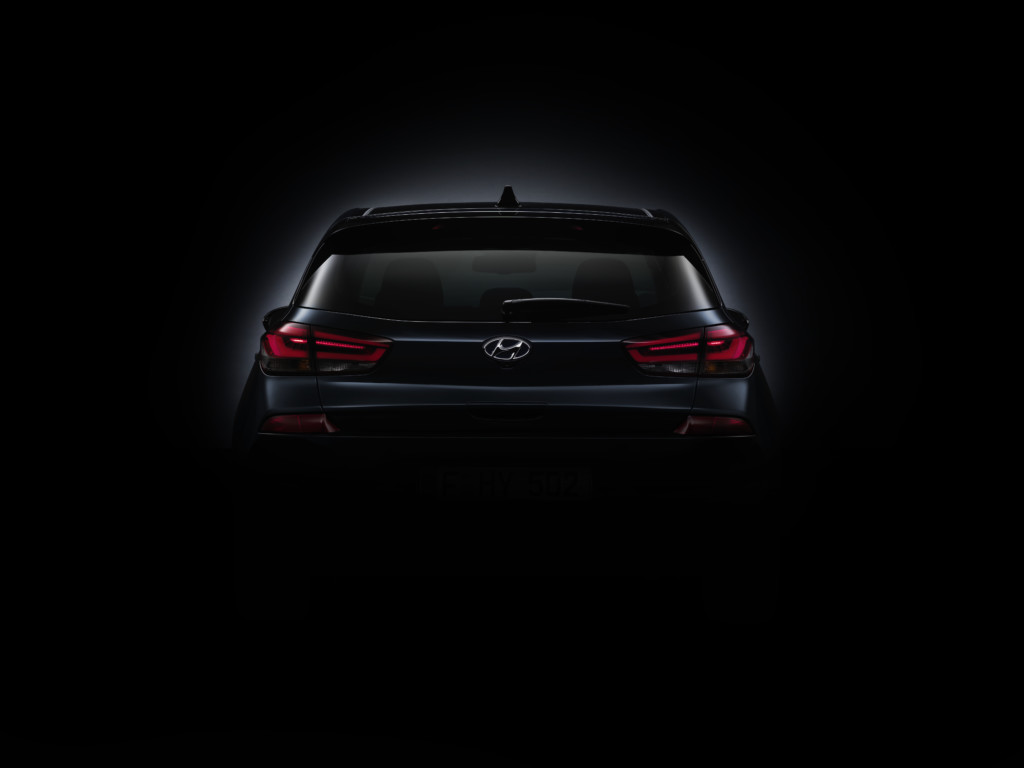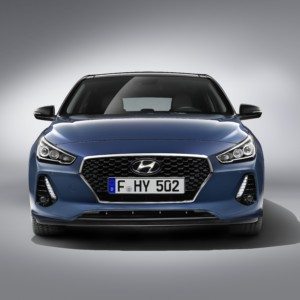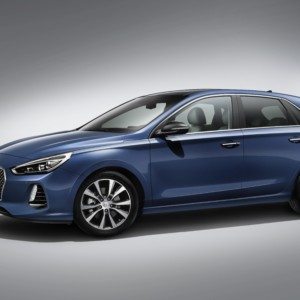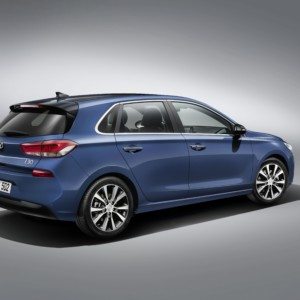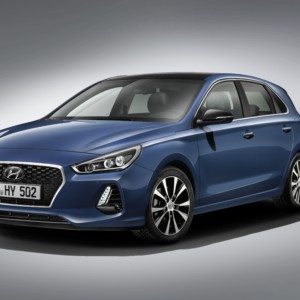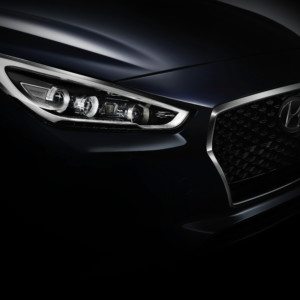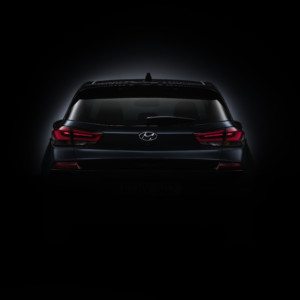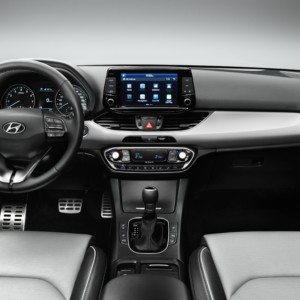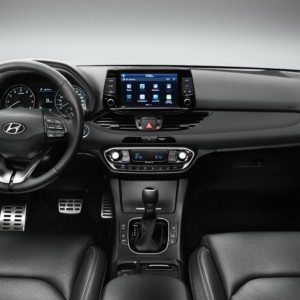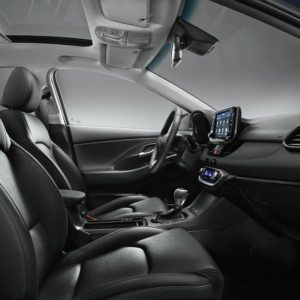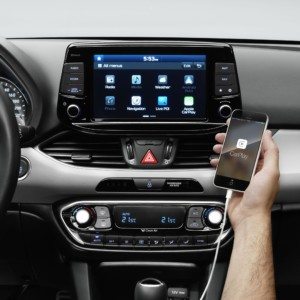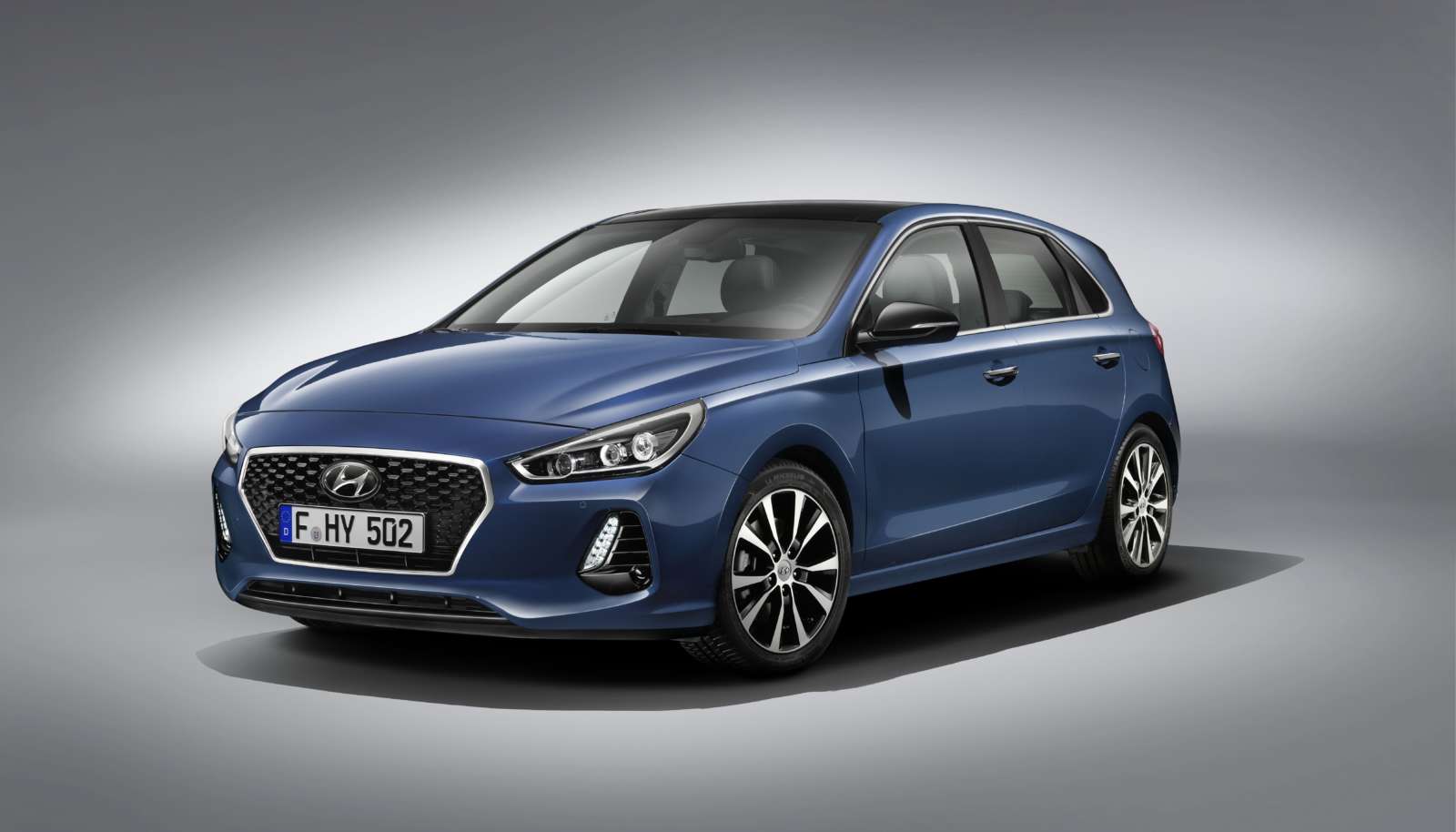
The new generation Hyundai i30 premium hatchback has been revealed for Europe.
“We have listened closely to customer needs in redefining our offer to create a car for everyone. It’s the new people’s car: Accessible, appealing in design and great to drive,” comments Jochen Sengpiehl, Vice President Marketing at Hyundai Motor Europe. “With up-to-date infotainment and connectivity features we offer everything today’s digital natives and modern customers expect.”
“To create a car for everyone, we focused on a wide range of different people,” explains Peter Schreyer, President and Chief Design Officer of Hyundai Motor Group, “So the design is an evolution of Hyundai Motor’s design language with natural flowing lines, refined surfaces and a sculpted body to create a timeless appearance.”
Exterior Design
The all-new i30’s design is headlined by the ‘Cascading Grille’, a design element which will eventually become the brand’s new design identity. The grille’s downward tapering gesture is said to be inspired by the momentous flow of poured molten steel. The grille features chrome-plated dots and a satin chrome surround, and is flanked by the three-projector full LED (low and high beam) headlamps along with the LED vertical daytime running lights with indicator function. Like on the new Elantra, the projector-type front, fog lamps are integrated into the air curtains.
In profile, the all-new i30 features short front and rear overhangs, a slightly sloping roof-line, and a long bonnet with a moved back A pillar. A single character flows from the headlamp along the almost horizontal belt line to connect with LED rear lamps and further wraps around the rear. The new Hyundai i30 claims to have a Coefficient of Drag of only 0.30. Its rear end design is characterized with a signature light graphic incorporating the high-positioned reflectors and fog lamps, along with a black rear spoiler.
The new Hyundai i30 is available with 17-inch two tone 10-spoke alloy wheels, 16-inch two-tone 10-spoke alloy wheels or 15-inch steel and alloy wheels. It will be available in twelve exterior colours consisting of three pearl choices: Stargazing Blue, Micron Gray, Phantom Black; and seven metallic choices: Demitasse Brown, Intense Copper, Moon Rock, Fiery Red, Platinum Sliver, Ara Blue and White Sand plus two solid choices: Engine Red and Polar White. (Subject to market specification)
Interior Design
The highlight of the new i30’s interior is the floating screen of the optional eight-inch navigation touch screen on the dashboard that integrates all navigation, media and connectivity features. Other features include a new multi-function three-spoke steering that’s heated, automatic climate control, optional panoramic glass sunroof which allows to tilt or to slide open, sliding front armrests that may also be opened to access additional storage underneath, and a luggage capacity of up to 395 litres with a ski hatch in the rear centre seat.
For the interior, customers can choose from three colour options: Oceanids black with two different cloth seat options or black leather seats, a two tone combination of Slate Grey and Oceanids black with cloth or leather seats featuring diamond pattern or the two tone combination of Indigo Blue and Oceanids Black with leather seats. The driver’s seat comes with a memory seat function with two programmable seat positions.
Choice of Powertrains
The New Generation i30 is powered by a range of small-displacement turbo charged petrol and diesel engines. There are three petrol engines and one diesel engine. Customers can choose between the new 1.4 T-GDI turbocharged four cylinder engine – a Hyundai first – with 140 PS and 242 Nm of torque, the 1.0 T-GDI turbocharged three cylinder engine with 120 PS and 170 Nm of torque, or the 1.4 MPI four cylinder with 100 PS.
There is one diesel engine: the 1.6-litre turbocharged four-cylinder unit, available in three states of tune: 95, 110 and 133 PS, with the most powerful version offering a healthy 275 Nm of torque. Mated to the engines is either the six-speed manual transmission (6MT) or Hyundai’s seven-speed dual-clutch transmission (7DCT). While the new, turbocharged 1.4-litre T-GDI petrol engine is offered with the 6MT or the 7DCT, the 1.0 T-GDI is offered with the 6MT. Meanwhile, all the diesel engines can be selected with the 6MT or 7DCT.
Ride and Handling
Compared to its predecessor the steering is said to be 10% more direct and the vehicle response is 15 milliseconds faster. The new chassis of the new i30 has been completely reworked with a standard multi-link rear suspension for all versions with a dual lower arm and the performance-oriented shock absorbers. The new i30 gets 288 mm brake discs up front, and a body crafted out of 53% Advanced High-Strength Steel. The latter implementation helps reducing the weight of the body-in-white by 28 kg and increasing rigidity by 22% in comparison to its predecessor. In production, the structural adhesives length has been increased to 112 m, improving stiffness while reducing weight.
Infotainment
Customers of the new Hyundai i30 can choose between the standard audio system with a five-inch capacitive LCD touch screen with integrated dynamic rear-view camera, Bluetooth connectivity and My Music functionality or the optional navigation system with an eight-inch capacitive touch screen. The new i30 provides both Apple CarPlay and Android Auto, as well as a wireless inductive charging pad (Qi standard) for mobile phones and a USB port located in the closed centre console.
The new navigation system comes with a seven-year free subscription to TomTom LIVE services. TomTom LIVE offers updated information in real time: weather, traffic, speed cameras and online searches for points of interest. The navigation system features 3D maps and is capable to display photos if you connect an USB stick.
Active Safety
The new i30 features a host of active safety features to comply with the highest European safety standards: Autonomous Emergency Braking with Front Collision Warning System, Smart Cruise Control, Blind Spot Detection, Rear Cross Traffic Alert, Lane Keeping Assist System, Speed Limit Information Function and High Beam Assist. New to the Hyundai line-up is the Driver Attention Alert feature.
Around the interior of the new i30, a total of seven airbags are installed, including a knee airbag for the driver. Beside the six standard airbags (2 front airbags, two side airbags to curtain airbags from first to second row protecting both driver and passengers), the knee airbag is an additional safety feature for the driver in the event of a front collision.
New Hyundai i30 Technical Specifications
All technical specifications and emission values are preliminary target values and subject to homologation.
[NOTE – Specification may vary by market / region]
Body & Chassis
Five-door, five-seater hatchback. Choice of one transversely mounted diesel and three gasoline engines driving the front wheels via a six-speed manual or seven-speed automatic transmission – depending on model and market.
Gasoline engines
| 1.4 MPi100 PS | |
| Type | KAPPA 1.4 MPI, 16-valve, DOHC D-CVVT |
| Capacity | 1368 cc |
| Bore x stroke | 71.6 x 84.0 mm |
| Compression ratio | 10.5 |
| Power | 100 PS (73.3 kW) @ 6000 rpm |
| Torque | 134 Nm @ 4000 rpm |
| 1.0 T-GDi 120 PS | |
| Type | KAPPA 1.0 T-GDI, 12-valve, DOHC D-CVVT |
| Capacity | 998 cc |
| Bore x stroke | 71.0 x 84.0 mm |
| Compression ratio | 10.0 |
| Power | 120 PS (88.3 kW) @ 6000 rpm |
| Torque | 171.1 Nm @ 1.500 ~ 4.000 rpm |
| 1.4 T-GDi 140 PS | |
| Type | KAPPA 1.4 T-GDI, 16-valve, DOHC D-CVVT |
| Capacity | 1353 cc |
| Bore x stroke | 71.6 x 84.0 mm |
| Compression ratio | 10.0 |
| Power | 140 PS (103 kW) @ 6000 rpm |
| Torque | 242 Nm @ 1500 rpm |
Diesel engines
| 1.6-litre 95 PS | |
| Type | U 1.6 (LOW), 16-valve, DOHC |
| Capacity | 1582 cc |
| Bore x stroke | 77.2 x 84.5 mm |
| Compression ratio | 16,0 |
| Power | 95 PS (70 kW) @ 4000 rpm |
| Torque | 280 Nm @1500~2000 rpm |
| 1.6-litre 110 PS | |
| Type | U 1.6 (MID), 16-valve, DOHC |
| Capacity | 1582 cc |
| Bore x stroke | 77.2 x 84.5 mm |
| Compression ratio | 16,0 |
| Power | 110 PS (81 kW) @ 4000 rpm (6MT) |
| Torque | 280 Nm @ 1500~2500 rpm (6MT) |
| 1.6-litre 136 PS | |
| Type | U 1.6 (HIGH), 16-valve, DOHC |
| Capacity | 1582 cc |
| Bore x stroke | 77.2 x 84.5 mm |
| Compression ratio | 16,0 |
| Power | 136 PS (100 kW) @ 4000 rpm (7DCT) |
| Torque | 280 Nm @ 1500~3000 rpm (136ps 6MT) 300 Nm @ 1750~2500 (7DCT) |
Transmissions
Gasoline engines – speeds
| Engine | 1.4 MPi (100) | 1.0 T-GDi (120) | 1.4 T-GDi (140) |
| Manual | 6 | 6 | 6 |
| DCT | – | – | 7 |
Diesel engines – speeds
| Engine | 1.6 CRDi (95) | 1.6 CRDi (110) | 1.6 CRDi (136) |
| Manual | 6 | 6 | 6 |
| DCT | – | 7 | 7 |
Gear ratios
| Gasoline | ||||||
| 1.4 (100)6MT |
1.0 (120) | 1.4 (140) | ||||
| 6MT | 6MT Eco | 6MT Basic | 6MT Eco | 7DCT | ||
| 1st | 3.769 | 3.615 | 3.615 | 3.615 | 3.615 | 3.929 |
| 2nd | 2.045 | 1.955 | 1.955 | 1.962 | 1.962 | 2.318 |
| 3rd | 1.370 | 1.286 | 1.286 | 1.257 | 1.257 | 2.043 |
| 4th | 1.036 | 0.971 | 0.971 | 0.951 | 0.951 | 1.070 |
| 5th | 0.893 | 0.774 | 0.774 | 0.778 | 0.778 | 0.822 |
| 6th | 0.774 | 0.639 | 0.639 | 0.633 | 0.633 | 0.884 |
| 7th | – | – | – | – | – | 0.721 |
| Rev. | 3.700 | 3.700 | 3.700 | 3.583 | 3.583 | 5.304 |
| Final drive | 4.400 | 4.267 | 4.059 | 4.188 | 3.941 | 4.294(1245) 3.174(367R) |
| Diesel | ||||||
| 1.6 (95)
6MT |
1.6 (110) | 1.6 (136) | ||||
| 6MT | 6MT Eco | 7DCT | 6MT | 7DCT | ||
| 1st | 3.769 | 3.636 | 3.769 | 3.786 | 3.636 | 3.786 |
| 2nd | 2.040 | 1.962 | 2.040 | 2.261 | 1.962 | 2.261 |
| 3rd | 1.189 | 1.189 | 1.189 | 1.957 | 1.189 | 1.957 |
| 4th | 0.844 | 0.844 | 0.804 | 1.023 | 0.844 | 1.023 |
| 5th | 0.702 | 0.702 | 0.660 | 0.778 | 0.702 | 0.778 |
| 6th | 0.596 | 0.596 | 0.549 | 0.837 | 0.596 | 0.837 |
| 7th | – | – | – | 0.681 | – | 0.681 |
| Rev. | 3.583 | 3.583 | 3.583 | 5.074 | 3.583 | 5.074 |
| Final drive | 3.250 | 3.471 | 3.250 | 4.176(1245) 3.087(367R) |
3.706 | 4.176(1245) 3.087(367R) |
Suspension
| Front | McPherson Strut |
| Rear | Multi-Link |
Steering
| Type | MDPS (Motor driven Power Steering) |
| Steering Gear ratio | 13.4 |
| Turning radius | 5.3 metres |
| Steering wheel turns lock-to-lock | 2.57 |
Brakes
| Front | Disc Type, 15″ : STD /16″ : OPT |
| Rear | Disc Type, 14″ : STD (HAND PARKING) /15″ : OPT (EPB) |
| Master Cylinder | Φ23.8 |
| Booster Size | 11″ (LHD GSL) 10″ (LHD DSL, RHD GSL, RHD DSL)” |
Wheels and tyres
| Wheel type | Tyres |
| 6,0J x 15 inch steel / alloy | 195 / 65 R15 |
| 6,5J x 16 inch alloy | 205 / 55 R16 |
| 7,0J x 17 inch alloy | 225 / 45 R17 |
Dimensions (mm)
Exterior
| Overall length | 4.340 |
| Overall width | 1.795 |
| Overall height | 1455 (1450 Eco) |
| Wheelbase | 2.650 |
| Front overhang | 905 |
| Rear overhang | 785 |
| Ground clearance | 140 (135 Eco) |
Interior
| Front | Rear | |
| Head room | 994 | 977 |
| Leg room | 1.073 | 883 |
| Shoulder room | 1427 | 1406 |
Capacities (litres)
| Fuel tank | 50 |
| Luggage | Minimum 395 |
| Maximum 1301 |
Weights* (kg)
| Gasoline | Diesel | ||||||||
| 1.4 MPi (100) 6MT |
1.0 T-GDi (120) 6MT |
1.4 T-GDi (140) | 1.6 CRDi (95) | 1.6 CRDi (110) |
1.6 CRDi (136) |
||||
| 6MT | 7DCT | 6MT | 6MT | 7DCT | 6MT | 7DCT | |||
| Curb weight | 1.169 – 1.316 | 1.194 – 1.342 | 1.204 – 1.352 | 1.240 – 1.388 | 1.263 – 1.411 | 1.263 – 1.411 | 1.293 – 1.441 | 1.263 – 1.411 | 1.293 – 1.441 |
| Gross vehicle weight | 1.760 | 1.800 | 1.820 | 1.850 | 1.860 | 1.860 | 1.900 | 1.860 | 1.900 |
Performance & Fuel Consumption*
Gasoline (manual/automatic)
| Engine | 1,4 MPI (100) (6MT) |
1,0 T-GDI (120) (6MT / 6MT Eco) |
1,4 T-GDI (140 (6MT / 6MT Eco / 7DCT) |
| Maximum speed (km/h) | 183 | 190 / 187 | 210 / 208 / 205 |
| 0-100 km/h (seconds) | 12.7 | 11.1 / 11.3 | 8.9 / 9.1 / 9.2 |
| CO2 combined (g/km) | 15’’:126 16’’-17’’: 130 |
15’’:112 / 103 16’’-17’’: 117 / 108 |
15’’: 119 / 109 / 121 16’’-17’’: 123 / 114 / 125 |
Diesel (manual/automatic)
| Engine | U2 1.6 (95) (6MT) |
U2 1.6 (110) (6MT / 6MT Eco / 7DCT) |
U2 1,6 (136) (6MT / 7DCT) |
| Maximum speed (km/h) | 186 | 190 / 188 / 190 | 200 / 200 |
| 0-100 km/h (seconds) | 12.2 | 11.0 / 10.7 /11.2 | 10.2 / 10.6 |
| CO2 combined (g/km) | 15’’: 95 16’’-17’’: 98 |
15’’: 96 / 89 / 105 16’’-17’’: 99/95 / 109 |
15’’: 99 / 105 16’’-17’’: 102 / 109 |
*Official combined cycle test –All values are tentative and not homologated yet, hence subject to changes

